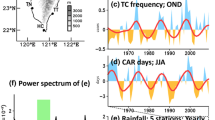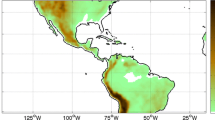Abstract
Precipitation over the contiguous United States exhibits large multi-decadal oscillations since the early twentieth century, and they often lead to dry (e.g., 1946–1976 and 1999-present) and wet (e.g., 1977–1998) periods and apparent precipitation trends (e.g., from the 1950s to 1990s) over most of the western and central US. The exact cause of these inter-decadal variations is not fully understood. Using observational and reanalysis data and model simulations, this paper examines the influence of the Inter-decadal Pacific Oscillation (IPO) on US precipitation. The IPO is a leading mode of sea surface temperatures (SSTs) seen mostly in the Pacific Ocean. It is found that decadal precipitation variations over much of the West and Central US, especially the Southwest, closely follow the evolution of the IPO (r = 0.85 during 1923–2010 for the Southwest US), and the dry and wet periods are associated, respectively, with the cold and warm phases of the IPO. In particular, the apparent upward trend from the 1950s–1990s and the dry decade thereafter in precipitation over much of the West and Central US are largely caused by the IPO cycles, which switched to a warm phase around 1977 and back to a cold phase around 1999. An atmospheric model forced with observed SSTs reproduces much of this association of US precipitation with the IPO (r = 0.95 between smoothed observed and simulated Southwest US precipitation during 1950–2009 and r = 0.88 between the simulated Southwest US precipitation and the IPO). Atmospheric reanalysis and model data both show a strong high (low) pressure center and anti-cyclonic (cyclonic) anomaly circulation over the North Pacific in the lower troposphere during cold (warm) phases of the IPO, which lead to dry and cold northwesterly and northerly winds and below-normal precipitation over much of the West US during IPO cold periods. The IPO induced changes are most pronounced during the boreal cold season. The results reinforce the notion that tropical Pacific SSTs (and the accompanying SST anomalies in the North Pacific) have large impacts on US precipitation and highlight the need to understand and simulate the IPO for decadal prediction of US precipitation.












Similar content being viewed by others
References
Alexander MA, Bladé I, Newman M, Lanzante JR, Lau N-C, Scott JD (2002) The atmospheric bridge: the influence of ENSO teleconnections on air–sea interaction over the global oceans. J Climate 15:2205–2231
Burke EJ, Brown SJ (2008) Evaluating uncertainties in the projection of future drought. J Hydrometeorol 9:292–299
Chen M, Xie P, Janowiak JE, Arkin PA (2002) Global land precipitation: a 50-year monthly analysis based on gauge observations. J Hydrometeorol 3:249–266
Chou C, Neelin JD, Chen CA, Tu JY (2009) Evaluating the “rich-get-richer’’ mechanism in tropical precipitation change under global warming. J Climate 22:1982–2005
Dai A (2011a) Drought under global warming: a review. WIREs Clim Change 2:45–65
Dai A (2011b) Characteristics and trends in various forms of the Palmer Drought Severity Index (PDSI) during 1900–2008. J Geophys Res 116:D12115. doi:10.1029/2010JD015541
Dai A, Wigley TML (2000) Global patterns of ENSO-induced precipitation. Geophys Res Lett 27:1283–1286
Dai A, Fung IY, Del Genio AD (1997) Surface observed global land precipitation variations during 1900–88. J Climate 10:2943–2962
Dai A (2012) Increasing drought under global warming in observations and models. Nat Clim Change (in press)
Deser C, Phillips AS, Hurrell JW (2004) Pacific interdecadal climate variability: linkages between the tropics and the North Pacific during boreal winter since 1900. J Climate 17:3109–3124
Feng S, Hu Q, Oglesby RJ (2011) Influence of Atlantic sea surface temperatures on persistent drought in North America. Clim Dynam 37:569–586
Hoerling M, Eischeid J, Perlwitz J (2010) Regional precipitation trends: distinguishing natural variability from anthropogenic forcing. J Climate 23:2131–2145
Hu Q, Feng S (2012) AMO- and ENSO-driven summertime circulation and precipitation variations in North America. J Clim. doi:10.1175/JCLI-D-11-00520.1
Hu Q, Feng S, Oglesby RJ (2011) Variations in North American summer precipitation driven by the Atlantic Multidecadal Oscillation. J Climate 24:5555–5570
Huffman GJ, Adler RF, Bolvin DT, Gu GJ (2009) Improving the global precipitation record: GPCP version 2.1. Geophys Res Lett 36:L17808. doi:10.1029/2009GL040000
IPCC (2007) Climate change 2007: the physical science basis. Cambridge University Press, Cambridge 996 pp
Kushnir Y, Seager R, Ting MF, Naik N, Nakamura J (2010) Mechanisms of tropical Atlantic SST influence on North American precipitation variability. J Climate 23:5610–5628
Mantua NJ, Hare SR, Zhang Y, Wallace JM, Francis RC (1997) A Pacific interdecadal climate oscillation with impacts on salmon production. Bull Am Meteorol Soc 78:1069–1079
Meehl GA, Hu AX (2006) Megadroughts in the Indian monsoon region and southwest North America and a mechanism for associated multidecadal Pacific sea surface temperature anomalies. J Climate 19:1605–1623
Meehl GA, Hu AX, Tebaldi C (2010) Decadal prediction in the Pacific region. J Climate 23:2959–2973
Mo KC, Schemm JKE, Yoo SH (2009) Influence of ENSO and the Atlantic Multidecadal Oscillation on drought over the United States. J Climate 22:5962–5982
Newman M, Compo GP, Alexander MA (2003) ENSO-forced variability of the Pacific Decadal Oscillation. J Climate 16:3853–3857
Nigam S, Guan B, Ruiz-Barradas A (2011) Key role of the Atlantic Multidecadal Oscillation in 20th century drought and wet periods over the great plains. Geophys Res Lett 38:L16713. doi:10.1029/2011GL048650
Power S, Casey T, Folland C, Colman A, Mehta V (1999) Inter-decadal modulation of the impact of ENSO on Australia. Clim Dynam 15:319–324
Rayner NA, Parker DE, Horton EB, Folland CK, Alexander LV, Rowell DP, Kent EC, Kaplan A (2003) Global analyses of sea surface temperature, sea ice, and night marine air temperature since the late nineteenth century. J Geophys Res 108:4407. doi:10.1029/2002JD002670
Schubert SD, Suarez MJ, Pegion PJ, Koster RD, Bacmeister JT (2004a) On the cause of the 1930s Dust Bowl. Science 303:1855–1859
Schubert SD, Suarez MJ, Pegion PJ, Koster RD, Bacmeister JT (2004b) Causes of long-term drought in the US Great Plains. J Climate 17:485–503
Schubert S et al (2009) A US CLIVAR project to assess and compare the responses of global climate models to drought-related SST forcing patterns: overview and results. J Climate 22:5251–5272
Seager R, Kushnir Y, Herweijer C, Naik N, Velez J (2005) Modeling of tropical forcing of persistent droughts and pluvial over western North America: 1856–2000. J Climate 18:4065–4088
Seager R et al (2007) Model projections of an imminent transition to a more arid climate in southwestern North America. Science 316:1181–1184
Sheffield J, Wood EF (2008) Projected changes in drought occurrence under future global warming from multi-model, multi-scenario, IPCC AR4 simulations. Clim Dynam 31:79–105
Ting M, Wang H (1997) Summertime US precipitation variability and its relation to Pacific sea surface temperature. J Climate 10:1853–1873
Wang CZ, Enfield DB, Lee SK, Landsea CW (2006) Influences of the Atlantic warm pool on western hemisphere summer rainfall and Atlantic hurricanes. J Climate 19:3011–3028
Wang H, Schubert S, Suarez M, Koster R (2010) The physical mechanisms by which the leading patterns of SST variability impact US precipitation. J Climate 23:1815–1836
Zhang Y, Wallace JM, Battisti DS (1997) ENSO-like interdecadal variability: 1900–93. J Climate 10:1004–1020
Zhong YF, Liu ZY, Notaro M (2011) A GEFA assessment of observed global ocean influence on US precipitation variability: attribution to regional SST variability modes. J Climate 24:693–707
Acknowledgments
The author is grateful to the Canadian Centre for Climate Modelling and Analysis, the UK. Met Office Hadley Centre and the PCMDI for making the model and SST datasets available to the public, and Ben Sanderson and John Fasullo for providing some of the model and ERA-Interim data files.
Author information
Authors and Affiliations
Corresponding author
Additional information
The National Center for Atmospheric Research is sponsored by the US National Science Foundation.
Rights and permissions
About this article
Cite this article
Dai, A. The influence of the inter-decadal Pacific oscillation on US precipitation during 1923–2010. Clim Dyn 41, 633–646 (2013). https://doi.org/10.1007/s00382-012-1446-5
Received:
Accepted:
Published:
Issue Date:
DOI: https://doi.org/10.1007/s00382-012-1446-5




